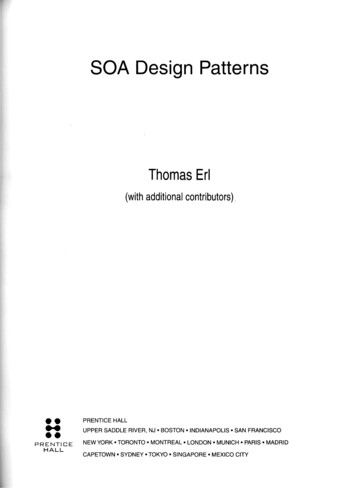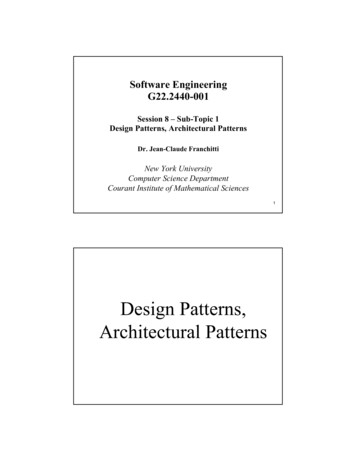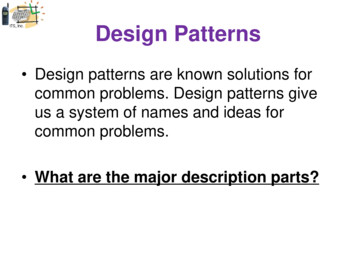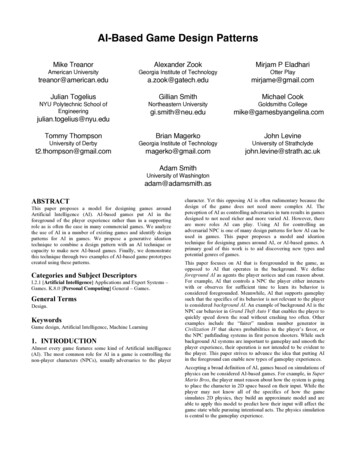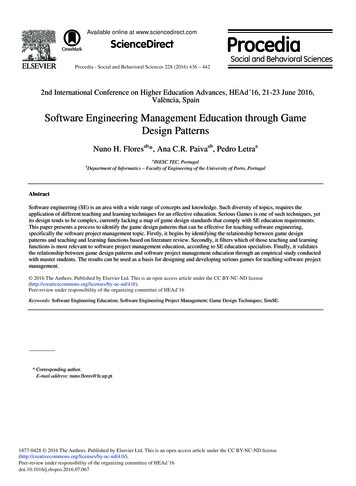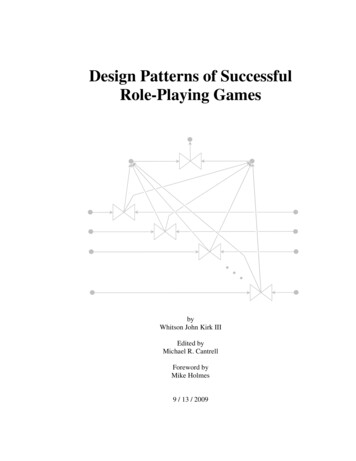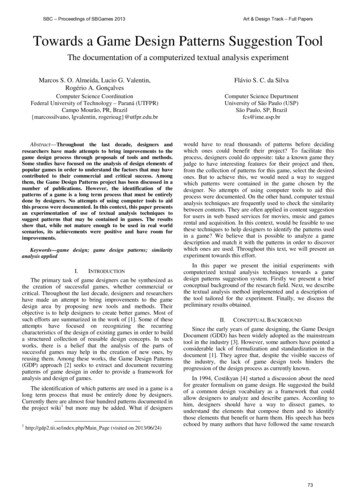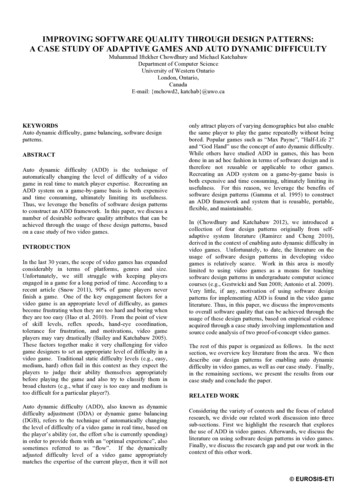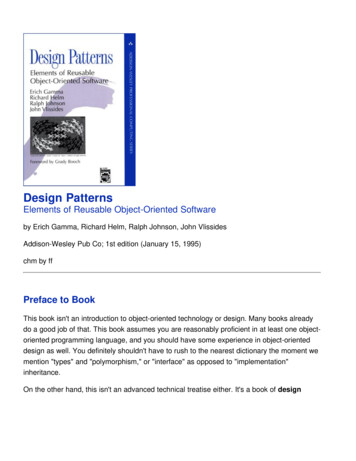
Transcription
Design PatternsElements of Reusable Object-Oriented Softwareby Erich Gamma, Richard Helm, Ralph Johnson, John VlissidesAddison-Wesley Pub Co; 1st edition (January 15, 1995)chm by ffPreface to BookThis book isn't an introduction to object-oriented technology or design. Many books alreadydo a good job of that. This book assumes you are reasonably proficient in at least one objectoriented programming language, and you should have some experience in object-orienteddesign as well. You definitely shouldn't have to rush to the nearest dictionary the moment wemention "types" and "polymorphism," or "interface" as opposed to "implementation"inheritance.On the other hand, this isn't an advanced technical treatise either. It's a book of design
patterns that describes simple and elegant solutions to specific problems in object-orientedsoftware design. Design patterns capture solutions that have developed and evolved overtime. Hence they aren't the designs people tend to generate initially. They reflect untoldredesign and recoding as developers have struggled for greater reuse and flexibility in theirsoftware. Design patterns capture these solutions in a succinct and easily applied form.The design patterns require neither unusual language features nor amazing programmingtricks with which to astound your friends and managers. All can be implemented in standardobject-oriented languages, though they might take a little more work than ad hoc solutions.But the extra effort invariably pays dividends in increased flexibility and reusability.Once you understand the design patterns and have had an "Aha!" (and not just a "Huh?")experience with them, you won't ever think about object-oriented design in the same way.You'll have insights that can make your own designs more flexible, modular, reusable, andunderstandable—which is why you're interested in object-oriented technology in the firstplace, right?A word of warning and encouragement: Don't worry if you don't understand this bookcompletely on the first reading. We didn't understand it all on the first writing! Remember thatthis isn't a book to read once and put on a shelf. We hope you'll find yourself referring to itagain and again for design insights and for inspiration.This book has had a long gestation. It has seen four countries, three of its authors'marriages, and the birth of two (unrelated) offspring. Many people have had a part in itsdevelopment. Special thanks are due Bruce Anderson, Kent Beck, and Andrι Weinand fortheir inspiration and advice. We also thank those who reviewed drafts of the manuscript:Roger Bielefeld, Grady Booch, Tom Cargill, Marshall Cline, Ralph Hyre, Brian Kernighan,Thomas Laliberty, Mark Lorenz, Arthur Riel, Doug Schmidt, Clovis Tondo, Steve Vinoski, andRebecca Wirfs-Brock. We are also grateful to the team at Addison-Wesley for their help andpatience: Kate Habib, Tiffany Moore, Lisa Raffaele, Pradeepa Siva, and John Wait. Specialthanks to Carl Kessler, Danny Sabbah, and Mark Wegman at IBM Research for theirunflagging support of this work.Last but certainly not least, we thank everyone on the Internet and points beyond whocommented on versions of the patterns, offered encouraging words, and told us that what wewere doing was worthwhile. These people include but are not limited to Jon Avotins, Steve
Berczuk, Julian Berdych, Matthias Bohlen, John Brant, Allan Clarke, Paul Chisholm, JensColdewey, Dave Collins, Jim Coplien, Don Dwiggins, Gabriele Elia, Doug Felt, Brian Foote,Denis Fortin, Ward Harold, Hermann Hueni, Nayeem Islam, Bikramjit Kalra, Paul Keefer,Thomas Kofler, Doug Lea, Dan LaLiberte, James Long, Ann Louise Luu, Pundi Madhavan,Brian Marick, Robert Martin, Dave McComb, Carl McConnell, Christine Mingins, HanspeterMφssenbφck, Eric Newton, Marianne Ozkan, Roxsan Payette, Larry Podmolik, GeorgeRadin, Sita Ramakrishnan, Russ Ramirez, Alexander Ran, Dirk Riehle, Bryan Rosenburg,Aamod Sane, Duri Schmidt, Robert Seidl, Xin Shu, and Bill Walker.We don't consider this collection of design patterns complete and static; it's more a recordingof our current thoughts on design. We welcome comments on it, whether criticisms of ourexamples, references and known uses we've missed, or design patterns we should haveincluded. You can write us care of Addison-Wesley, or send electronic mail to designpatterns@cs.uiuc.edu . You can also obtain softcopy for the code in the Sample Codesections by sending the message "send design pattern source" to design-patternssource@cs.uiuc.edu . And now there's a Web at ook.html for late-breaking information andupdates.Mountain View, California, E.G.Montreal, Quebec, R.H.Urbana, Illinois, R.J.Hawthorne, New York, J.V.August 1994Preface to CDAs we were writing Design Patterns , we knew the patterns we were describing had valuebecause they had proven themselves in many different contexts. Our hope was that othersoftware engineers would benefit from these patterns as much as we had.Now, three years after its debut, we find ourselves both grateful and thrilled by how the bookhas been received. Lots of people use it. Many tell us the patterns have helped them designand build better systems. Many others have been inspired to write their own patterns, and the
pool of patterns is growing. And many have commented on what might be improved aboutthe book and what they would like to see in the future.A recurring comment in all the feedback has been how well-suited the book is to hypertext.There are numerous cross-references, and chasing references is something a computer cando very well. Since much of the software development process takes place on computers, itwould be natural to have a book like ours as an on-line resource. Observations like these gotus excited about the potential of this medium. So when Mike Hendrickson approached usabout turning the book into a CD-ROM, we jumped at the chance.Two years and several megabytes of e-mail later, we're delighted that you can finally obtainthis edition, the Design Patterns CD , and put its unique capabilities to work. Now you canaccess a pattern from your computer even when someone has borrowed your book. You cansearch the text for key words and phrases. It's also considerably easier to incorporate partsof it in your own on-line documentation. And if you travel with a notebook computer, you cankeep the book handy without lugging an extra two pounds of paper.Hypertext is a relatively new publishing venue, one we are learning to use just like everyoneelse. If you have ideas on how to improve this edition, please send them to design-patternscd@cs.uiuc.edu. If you have questions or suggestions concerning the patterns themselves,send them to the gang-of-4-patterns@cs.uiuc.edu mailing list. (To subscribe, send e-mail togang-of-4-patterns@cs.uiuc.edu with the subject "subscribe".) This list has quite a fewreaders, and many of them can answer questions as well as we can—and usually a lot faster!Also, be sure to check out the Patterns Home at http://hillside.net/patterns/ . There you'll findother books and mailing lists on patterns, not to mention conference information and patternspublished on-line.This CD entailed considerable design and implementation work. We are indebted to MikeHendrickson and the team at Addison-Wesley for their on-going encouragement and support.Jeff Helgesen, Jason Jones, and Daniel Savarese garner many thanks for their developmenteffort and for patience despite what must appear to have been our insatiable appetite forrevision. A special acknowledgment is due IBM Research, which continues to underwritemuch of this activity. We also thank the reviewers, including Robert Brunner, Sandeep Dani,Bob Koss, Scott Meyers, Stefan Schulz, and the Patterns Discussion Group at the Universityof Illinois Urbana-Champaign. Their advice led to at least one major redesign and severalminor ones.
Finally, we thank all who have taken time to comment on Design Patterns . Your feedbackhas been invaluable to us as we strive to better our understanding and presentation of thismaterial.Zurich, Switzerland, E.G.Sydney, Australia, R.H.Urbana, Illinois, R.J.Hawthorne, New York, J.V.August 1997About the AuthorsThe authors are internationally recognized experts in the object-oriented software field. Dr.Erich Gamma is technical director at the Software Technology Center of Object TechnologyInternational in Zurich, Switzerland. Dr. Richard Helm is a member of the Object TechnologyPractice Group in the IBM Consulting Group in Sydney, Australia. Dr. Ralph Johnson is afaculty member at the University of Illinois at Urbana-Champaign's Computer ScienceDepartment. Dr. John Vlissides conducts his research at IBM's Thomas J. Watson ResearchCenter in Hawthorne, New York.Guide to ReadersThis book has two main parts. The first part (Chapters 1 and 2) describes what designpatterns are and how they help you design object-oriented software. It includes a design casestudy that demonstrates how design patterns apply in practice. The second part of the book(Chapters 3, 4, and 5) is a catalog of the actual design patterns.The catalog makes up the majority of the book. Its chapters divide the design patterns intothree types: creational, structural, and behavioral. You can use the catalog in several ways.You can read the catalog from start to finish, or you can just browse from pattern to pattern.Another approach is to study one of the chapters. That will help you see how closely relatedpatterns distinguish themselves.You can use the references between the patterns as a logical route through the catalog. This
approach will give you insight into how patterns relate to each other, how they can becombined with other patterns, and which patterns work well together. Figure 1.1 depictsthese references graphically.Yet another way to read the catalog is to use a more problem-directed approach. Skip toSection 1.6 to read about some common problems in designing reusable object-orientedsoftware; then read the patterns that address these problems. Some people read the catalogthrough first and then use a problem-directed approach to apply the patterns to their projects.If you aren't an experienced object-oriented designer, then start with the simplest and mostcommon patterns:Abstract FactoryAdapterCompositeDecoratorFactory MethodObserverStrategyTemplate MethodIt's hard to find an object-oriented system that doesn't use at least a couple of these patterns,and large systems use nearly all of them. This subset will help you understand designpatterns in particular and good object-oriented design in general
IntroductionDesigning object-oriented software is hard, and designing reusable object-oriented softwareis even harder. You must find pertinent objects, factor them into classes at the rightgranularity, define class interfaces and inheritance hierarchies, and establish keyrelationships among them. Your design should be specific to the problem at hand but alsogeneral enough to address future problems and requirements. You also want to avoidredesign, or at least minimize it. Experienced object-oriented designers will tell you that areusable and flexible design is difficult if not impossible to get "right" the first time. Before adesign is finished, they usually try to reuse it several times, modifying it each time.Yet experienced object-oriented designers do make good designs. Meanwhile new designersare overwhelmed by the options available and tend to fall back on non-object-orientedtechniques they've used before. It takes a long time for novices to learn what good objectoriented design is all about. Experienced designers evidently know something inexperiencedones don't. What is it?One thing expert designers know not to do is solve every problem from first principles.Rather, they reuse solutions that have worked for them in the past. When they find a goodsolution, they use it again and again. Such experience is part of what makes them experts.Consequently, you'll find recurring patterns of classes and communicating objects in manyobject-oriented systems. These patterns solve specific design problems and make objectoriented designs more flexible, elegant, and ultimately reusable. They help designers reusesuccessful designs by basing new designs on prior experience. A designer who is familiarwith such patterns can apply them immediately to design problems without having torediscover them.An analogy will help illustrate the point. Novelists and playwrights rarely design their plotsfrom scratch. Instead, they follow patterns like "Tragically Flawed Hero" (Macbeth, Hamlet,etc.) or "The Romantic Novel" (countless romance novels). In the same way, object-orienteddesigners follow patterns like "represent states with objects" and "decorate objects so youcan easily add/remove features." Once you know the pattern, a lot of design decisions followautomatically.We all know the value of design experience. How many times have you had design déjàvu—that feeling that you've solved a problem before but not knowing exactly where or how?
If you could remember the details of the previous problem and how you solved it, then youcould reuse the experience instead of rediscovering it. However, we don't do a good job ofrecording experience in software design for others to use.The purpose of this book is to record experience in designing object-oriented software asdesign patterns. Each design pattern systematically names, explains, and evaluates animportant and recurring design in object-oriented systems. Our goal is to capture designexperience in a form that people can use effectively. To this end we have documented someof the most important design patterns and present them as a catalog.Design patterns make it easier to reuse successful designs and architectures. Expressingproven techniques as design patterns makes them more accessible to developers of newsystems. Design patterns help you choose design alternatives that make a system reusableand avoid alternatives that compromise reusability. Design patterns can even improve thedocumentation and maintenance of existing systems by furnishing an explicit specification ofclass and object interactions and their underlying intent. Put simply, design patterns help adesigner get a design "right" faster.None of the design patterns in this book describes new or unproven designs. We haveincluded only designs that have been applied more than once in different systems. Most ofthese designs have never been documented before. They are either part of the folklore of theobject-oriented community or are elements of some successful object-orientedsystems—neither of which is easy for novice designers to learn from. So although thesedesigns aren't new, we capture them in a new and accessible way: as a catalog of designpatterns having a consistent format.Despite the book's size, the design patterns in it capture only a fraction of what an expertmight know. It doesn't have any patterns dealing with concurrency or distributedprogramming or real-time programming. It doesn't have any application domain-specificpatterns. It doesn't tell you how to build user interfaces, how to write device drivers, or how touse an object-oriented database. Each of these areas has its own patterns, and it would beworthwhile for someone to catalog those too.What is a Design Pattern?
Christopher Alexander says, "Each pattern describes a problem which occurs over and overagain in our environment, and then describes the core of the solution to that problem, in sucha way that you can use this solution a million times over, without ever doing it the same waytwice" [AIS 77, x]. Even though Alexander was talking about patterns in buildings and towns,what he says is true about object-oriented design patterns. Our solutions are expressed interms of objects and interfaces instead of walls and doors, but at the core of both kinds ofpatterns is a solution to a problem in a context.In general, a pattern has four essential elements:1. The pattern name is a handle we can use to describe a design problem, itssolutions, and consequences in a word or two. Naming a pattern immediatelyincreases our design vocabulary. It lets us design at a higher level of abstraction.Having a vocabulary for patterns lets us talk about them with our colleagues, in ourdocumentation, and even to ourselves. It makes it easier to think about designs andto communicate them and their trade-offs to others. Finding good names has beenone of the hardest parts of developing our catalog.2. The problem describes when to apply the pattern. It explains the problem and itscontext. It might describe specific design problems such as how to representalgorithms as objects. It might describe class or object structures that aresymptomatic of an inflexible design. Sometimes the problem will include a list ofconditions that must be met before it makes sense to apply the pattern.3. The solution describes the elements that make up the design, their relationships,responsibilities, and collaborations. The solution doesn't describe a particularconcrete design or implementation, because a pattern is like a template that can beapplied in many different situations. Instead, the pattern provides an abstractdescription of a design problem and how a general arrangement of elements(classes and objects in our case) solves it.4. The consequences are the results and trade-offs of applying the pattern. Thoughconsequences are often unvoiced when we describe design decisions, they arecritical for evaluating design alternatives and for understanding the costs andbenefits of applying the pattern. The consequences for software often concern
space and time trade-offs. They may address language and implementation issuesas well. Since reuse is often a factor in object-oriented design, the consequences ofa pattern include its impact on a system's flexibility, extensibility, or portability.Listing these consequences explicitly helps you understand and evaluate them.Point of view affects one's interpretation of what is and isn't a pattern. One person's patterncan be another person's primitive building block. For this book we have concentrated onpatterns at a certain level of abstraction. Design patterns are not about designs such aslinked lists and hash tables that can be encoded in classes and reused as is. Nor are theycomplex, domain-specific designs for an entire application or subsystem. The design patternsin this book are descriptions of communicating objects and classes that are customized tosolve a general design problem in a particular context.A design pattern names, abstracts, and identifies the key aspects of a common designstructure that make it useful for creating a reusable object-oriented design. The designpattern identifies the participating classes and instances, their roles and collaborations, andthe distribution of responsibilities. Each design pattern focuses on a particular object-orienteddesign problem or issue. It describes when it applies, whether it can be applied in view ofother design constraints, and the consequences and trade-offs of its use. Since we musteventually implement our designs, a design pattern also provides sample C and(sometimes) Smalltalk code to illustrate an implementation.Although design patterns describe object-oriented designs, they are based on practicalsolutions that have been implemented in mainstream object-oriented programminglanguages like Smalltalk and C rather than procedural languages (Pascal, C, Ada) or moredynamic object-oriented languages (CLOS, Dylan, Self). We chose Smalltalk and C forpragmatic reasons: Our day-to-day experience has been in these languages, and they areincreasingly popular.The choice of programming language is important because it influences one's point of view.Our patterns assume Smalltalk/C -level language features, and that choice determineswhat can and cannot be implemented easily. If we assumed procedural languages, we mighthave included design patterns called "Inheritance," "Encapsulation," and "Polymorphism."Similarly, some of our patterns are supported directly by the less common object-orientedlanguages. CLOS has multi-methods, for example, which lessen the need for a pattern such
as Visitor. In fact, there are enough differences between Smalltalk and C to mean thatsome patterns can be expressed more easily in one language than the other. (See Iteratorfor an example.)Design Patterns in Smalltalk MVCThe Model/View/Controller (MVC) triad of classes [KP88] is used to build user interfaces inSmalltalk-80. Looking at the design patterns inside MVC should help you see what we meanby the term "pattern."MVC consists of three kinds of objects. The Model is the application object, the View is itsscreen presentation, and the Controller defines the way the user interface reacts to userinput. Before MVC, user interface designs tended to lump these objects together. MVCdecouples them to increase flexibility and reuse.MVC decouples views and models by establishing a subscribe/notify protocol between them.A view must ensure that its appearance reflects the state of the model. Whenever themodel's data changes, the model notifies views that depend on it. In response, each viewgets an opportunity to update itself. This approach lets you attach multiple views to a modelto provide different presentations. You can also create new views for a model withoutrewriting it.The following diagram shows a model and three views. (We've left out the controllers forsimplicity.) The model contains some data values, and the views defining a spreadsheet,histogram, and pie chart display these data in various ways. The model communicates withits views when its values change, and the views communicate with the model to access thesevalues.
Taken at face value, this example reflects a design that decouples views from models. Butthe design is applicable to a more general problem: decoupling objects so that changes toone can affect any number of others without requiring the changed object to know details ofthe others. This more general design is described by the Observer design pattern.Another feature of MVC is that views can be nested. For example, a control panel of buttonsmight be implemented as a complex view containing nested button views. The user interfacefor an object inspector can consist of nested views that may be reused in a debugger. MVCsupports nested views with the CompositeView class, a subclass of View. CompositeViewobjects act just like View objects; a composite view can be used wherever a view can beused, but it also contains and manages nested views.Again, we could think of this as a design that lets us treat a composite view just like we treatone of its components. But the design is applicable to a more general problem, which occurswhenever we want to group objects and treat the group like an individual object. This moregeneral design is described by the Composite design pattern. It lets you create a class
hierarchy in which some subclasses define primitive objects (e.g., Button) and other classesdefine composite objects (CompositeView) that assemble the primitives into more complexobjects.MVC also lets you change the way a view responds to user input without changing its visualpresentation. You might want to change the way it responds to the keyboard, for example, orhave it use a pop-up menu instead of command keys. MVC encapsulates the responsemechanism in a Controller object. There is a class hierarchy of controllers, making it easy tocreate a new controller as a variation on an existing one.A view uses an instance of a Controller subclass to implement a particular response strategy;to implement a different strategy, simply replace the instance with a different kind ofcontroller. It's even possible to change a view's controller at run-time to let the view changethe way it responds to user input. For example, a view can be disabled so that it doesn'taccept input simply by giving it a controller that ignores input events.The View-Controller relationship is an example of the Strategy design pattern. A Strategy isan object that represents an algorithm. It's useful when you want to replace the algorithmeither statically or dynamically, when you have a lot of variants of the algorithm, or when thealgorithm has complex data structures that you want to encapsulate.MVC uses other design patterns, such as Factory Method to specify the default controllerclass for a view and Decorator to add scrolling to a view. But the main relationships in MVCare given by the Observer, Composite, and Strategy design patterns.Describing Design PatternsHow do we describe design patterns? Graphical notations, while important and useful, aren'tsufficient. They simply capture the end product of the design process as relationshipsbetween classes and objects. To reuse the design, we must also record the decisions,alternatives, and trade-offs that led to it. Concrete examples are important too, because theyhelp you see the design in action.We describe design patterns using a consistent format. Each pattern is divided into sectionsaccording to the following template. The template lends a uniform structure to theinformation, making design patterns easier to learn, compare, and use.
Pattern Name and ClassificationThe pattern's name conveys the essence of the pattern succinctly. A good name is vital,because it will become part of your design vocabulary. The pattern's classification reflectsthe scheme we introduce in Section 1.5.IntentA short statement that answers the following questions: What does the design pattern do?What is its rationale and intent? What particular design issue or problem does it address?Also Known AsOther well-known names for the pattern, if any.MotivationA scenario that illustrates a design problem and how the class and object structures in thepattern solve the problem. The scenario will help you understand the more abstractdescription of the pattern that follows.ApplicabilityWhat are the situations in which the design pattern can be applied? What are examples ofpoor designs that the pattern can address? How can you recognize these situations?StructureA graphical representation of the classes in the pattern using a notation based on theObject Modeling Technique (OMT) [RBP 91]. We also use interaction diagrams [JCJO92,Boo94] to illustrate sequences of requests and collaborations between objects. Appendix Bdescribes these notations in detail.ParticipantsThe classes and/or objects participating in the design pattern and their responsibilities.CollaborationsHow the participants collaborate to carry out their responsibilities.ConsequencesHow does the pattern support its objectives? What are the trade-offs and results of using
the pattern? What aspect of system structure does it let you vary independently?ImplementationWhat pitfalls, hints, or techniques should you be aware of when implementing the pattern?Are there language-specific issues?Sample CodeCode fragments that illustrate how you might implement the pattern in C or Smalltalk.Known UsesExamples of the pattern found in real systems. We include at least two examples fromdifferent domains.Related PatternsWhat design patterns are closely related to this one? What are the important differences?With which other patterns should this one be used?The appendices provide background information that will help you understand the patternsand the discussions surrounding them. Appendix A is a glossary of terminology we use.We've already mentioned Appendix B, which presents the various notations. We'll alsodescribe aspects of the notations as we introduce them in the upcoming discussions. Finally,Appendix C contains source code for the foundation classes we use in code samples.The Catalog of Design PatternsThe catalog beginning on contains 23 design patterns. Their names and intents are listednext to give you an overview. The number in parentheses after each pattern name gives thenumber for the pattern (a convention we follow throughout the book).Abstract FactoryProvide an interface for creating families of related or dependent objects without specifyingtheir concrete classes.
AdapterConvert the interface of a class into another interface clients expect. Adapter lets classeswork together that couldn't otherwise because of incompatible interfaces.BridgeDecouple an abstraction from its implementation so that the two can vary independently.BuilderSeparate the construction of a complex object from its representation so that the sameconstruction process can create different representations.Chain of ResponsibilityAvoid coupling the sender of a request to its receiver by giving more than one object achance to handle the request. Chain the receiving objects and pass the request along thechain until an object handles it.CommandEncapsulate a request as an object, thereby letting you parameterize clients with differentrequests, queue or log requests, and support undoable operations.CompositeCompose objects into tree structures to represent part-whole hierarchies. Composite letsclients treat individual objects and compositions of objects uniformly.DecoratorAttach additional responsibilities to an object dynamically. Decorators provide a flexiblealternative to subclassing for extending functionality.FacadeProvide a unified interface to a set of interfaces in a subsystem. Facade defines a higherlevel interface that makes the subsystem easier to use.Factory MethodDefine an interface for creating an object, but let subclasses decide which class toinstantiate. Factory Method lets a class defer instantiation to subclasses.Flyweight
Use sharing to support large numbers of fine-grained objects efficiently.InterpreterGiven a language, define a represention for its grammar along with an interpreter that usesthe representation to interpret sentences in the lang
else. If you have ideas on how to improve this edition, please send them to design-patterns-cd@cs.uiuc.edu. If you have questions or suggestions concerning the patterns themselves, send them to the gang-of-4-patterns@cs.uiuc.edu mailing list. (To subscribe, send e-mail to gang-of-4-patterns@cs.uiuc.edu with the subject "subscribe".)
